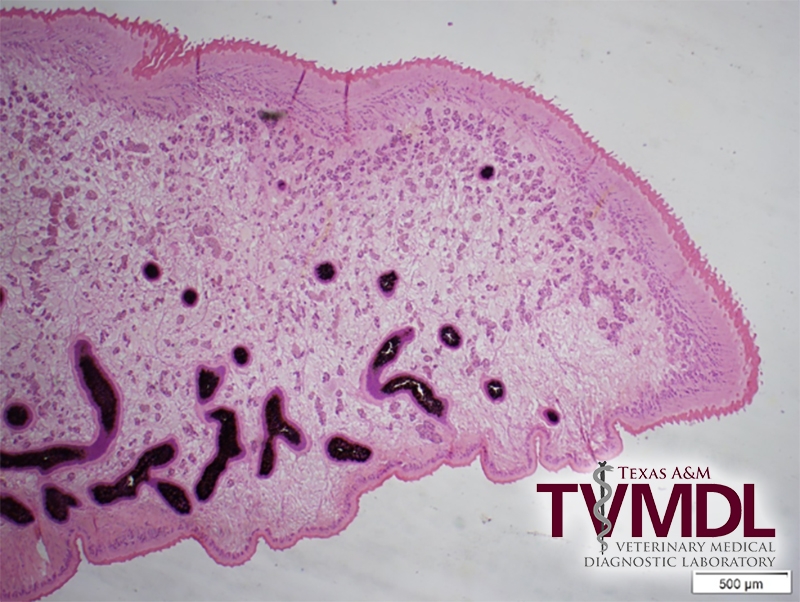Bacillary hemoglobinuria in feeder cattle
Jessie Monday DVM, MS & R.G. Helman, DVM, MA, PhD, DACVP
A veterinarian was investigating the cause of increased non-respiratory disease mortalities in beef feeder cattle. The cattle were 100-200 days on feed and had signs of systemic compromise before acute death. On necropsy, the animals had advanced autolysis of the peritoneal organs, especially the liver and kidneys, and bladder distention. The bladders contained clotted blood and pigmented urine.
Tissues and urine were submitted to the Texas A&M Veterinary Medical Diagnostic Laboratory (TVMDL) for culture, histopathology, Leptospira spp. qPCR, and histotoxic clostridium FA. Culture of the liver and kidney was negative for pathologic organisms. Histopathology revealed mild to moderate chronic fibrosing portal hepatitis with intralesional fluke eggs and adult flukes. Liver histopathology also showed acute centrilobular to midzonal hepatic necrosis with bile stasis. Molecular diagnostics on the urine, kidney, and liver were negative for Leptospira spp. The histotoxic clostridium fluorescent antibody (FA) test indicated the presence of Clostridium novyi in the kidney. The same kidney was negative for the presence of Clostridium chauvoei or Clostridium septicum. Based on the clinical presentation, the mortality rate in the at-risk population, the necropsy, and other diagnostic testing findings, the cattle were diagnosed with bacillary hemoglobinuria.
Bacillary hemoglobinuria (“red water”) is caused by toxins produced by Clostridium novyi type D. This clostridium was previously known as Clostridium haemolyticum. C. novyiis commonly found in soil and spores are ingested and passed from the feces and urine of cattle grazing in pastures with C. novyi. Spores can be distributed to the internal organs (especially liver) in these otherwise clinically normal cattle. The same happens with the closely related Clostridium novyi type B which causes infectious necrotic hepatitis (“black disease”). Infectious necrotic hepatitis is differentiated from bacillary hemoglobinuria based on presentation, necropsy findings, and histopathology.
Clostridial bacteria require environments devoid of oxygen to grow and produce toxin. Therefore, the ideal environment for clostridial growth is only present in severely damaged or necrotic tissue. The most common underlying cause of liver damage that allows for the production of clostridial toxin is the migration of liver fluke larvae. Cattle infested with liver parasites are at higher risk of bacillary hemoglobinuria or black disease, although any cause of liver trauma theoretically could result in clostridial toxin production. Outbreaks of bacillary hemoglobinuria can occur when flooding distributes spores to previously clean areas. Proper fluke control and the use of appropriate clostridial bacterins can help prevent death from C. novyi toxin production. Duration of protection from vaccination, however, is only 5 to 6 months. As a result, timing of vaccination governed by local climate and liver fluke season is crucial.
Sudden death is the most common clinical presentation of bacillary hemoglobinuria and black disease. Bacillary hemoglobinuria may cause depression, anorexia, and fever. Dark red urine is often seen shortly before death or leaking from the animal after death. Affected cattle may have labored breathing with blood or bloody froth coming from the nostrils or rectal bleeding/bloody feces. Uncoagulated blood may also be seen from the nose or rectum after death. Decay of the tissues after death is very rapid so timely necropsy to obtain good diagnostic samples is important. TVMDL has a Bovine Sudden Death Tissue Panel as well as several other tests to guide the diagnostic investigation in cattle that die with few or no clinical signs.
For more information on this case contact Dr. Monday, veterinary diagnostician, or Dr. Helman, TVMDL Amarillo resident director. To learn more about TVMDL’s test offerings, visit tvmdl.tamu.edu or call 1.888.646.5624 for the Amarillo laboratory or 1.888.646.5623 for the College Station laboratory.
